Lixin Cui
Knowledge Probing for Graph Representation Learning
Aug 07, 2024Abstract:Graph learning methods have been extensively applied in diverse application areas. However, what kind of inherent graph properties e.g. graph proximity, graph structural information has been encoded into graph representation learning for downstream tasks is still under-explored. In this paper, we propose a novel graph probing framework (GraphProbe) to investigate and interpret whether the family of graph learning methods has encoded different levels of knowledge in graph representation learning. Based on the intrinsic properties of graphs, we design three probes to systematically investigate the graph representation learning process from different perspectives, respectively the node-wise level, the path-wise level, and the structural level. We construct a thorough evaluation benchmark with nine representative graph learning methods from random walk based approaches, basic graph neural networks and self-supervised graph methods, and probe them on six benchmark datasets for node classification, link prediction and graph classification. The experimental evaluation verify that GraphProbe can estimate the capability of graph representation learning. Remaking results have been concluded: GCN and WeightedGCN methods are relatively versatile methods achieving better results with respect to different tasks.
HC-GAE: The Hierarchical Cluster-based Graph Auto-Encoder for Graph Representation Learning
May 23, 2024Abstract:Graph Auto-Encoders (GAEs) are powerful tools for graph representation learning. In this paper, we develop a novel Hierarchical Cluster-based GAE (HC-GAE), that can learn effective structural characteristics for graph data analysis. To this end, during the encoding process, we commence by utilizing the hard node assignment to decompose a sample graph into a family of separated subgraphs. We compress each subgraph into a coarsened node, transforming the original graph into a coarsened graph. On the other hand, during the decoding process, we adopt the soft node assignment to reconstruct the original graph structure by expanding the coarsened nodes. By hierarchically performing the above compressing procedure during the decoding process as well as the expanding procedure during the decoding process, the proposed HC-GAE can effectively extract bidirectionally hierarchical structural features of the original sample graph. Furthermore, we re-design the loss function that can integrate the information from either the encoder or the decoder. Since the associated graph convolution operation of the proposed HC-GAE is restricted in each individual separated subgraph and cannot propagate the node information between different subgraphs, the proposed HC-GAE can significantly reduce the over-smoothing problem arising in the classical convolution-based GAEs. The proposed HC-GAE can generate effective representations for either node classification or graph classification, and the experiments demonstrate the effectiveness on real-world datasets.
ENADPool: The Edge-Node Attention-based Differentiable Pooling for Graph Neural Networks
May 16, 2024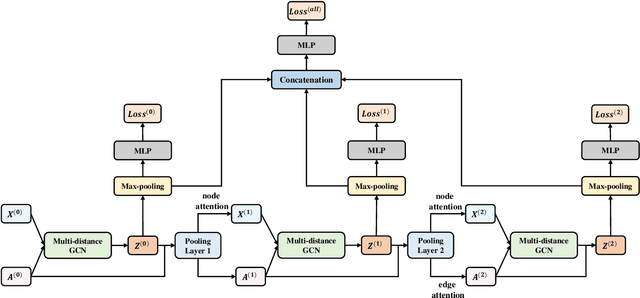
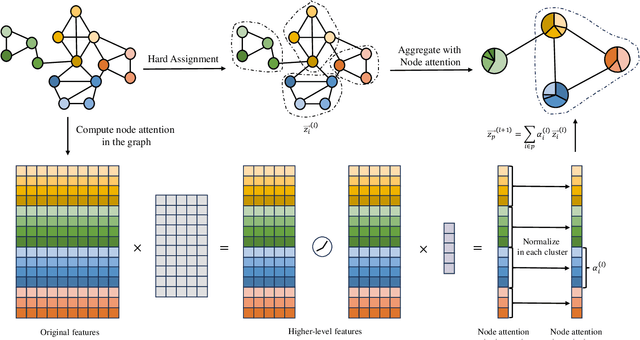
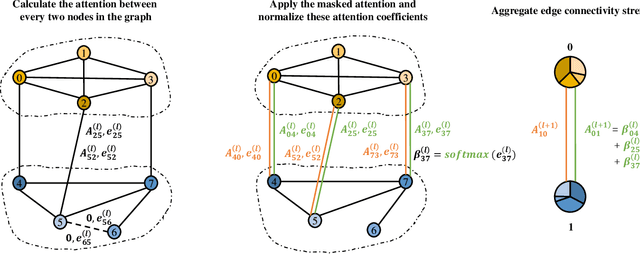

Abstract:Graph Neural Networks (GNNs) are powerful tools for graph classification. One important operation for GNNs is the downsampling or pooling that can learn effective embeddings from the node representations. In this paper, we propose a new hierarchical pooling operation, namely the Edge-Node Attention-based Differentiable Pooling (ENADPool), for GNNs to learn effective graph representations. Unlike the classical hierarchical pooling operation that is based on the unclear node assignment and simply computes the averaged feature over the nodes of each cluster, the proposed ENADPool not only employs a hard clustering strategy to assign each node into an unique cluster, but also compress the node features as well as their edge connectivity strengths into the resulting hierarchical structure based on the attention mechanism after each pooling step. As a result, the proposed ENADPool simultaneously identifies the importance of different nodes within each separated cluster and edges between corresponding clusters, that significantly addresses the shortcomings of the uniform edge-node based structure information aggregation arising in the classical hierarchical pooling operation. Moreover, to mitigate the over-smoothing problem arising in existing GNNs, we propose a Multi-distance GNN (MD-GNN) model associated with the proposed ENADPool operation, allowing the nodes to actively and directly receive the feature information from neighbors at different random walk steps. Experiments demonstrate the effectiveness of the MD-GNN associated with the proposed ENADPool.
AKBR: Learning Adaptive Kernel-based Representations for Graph Classification
Mar 24, 2024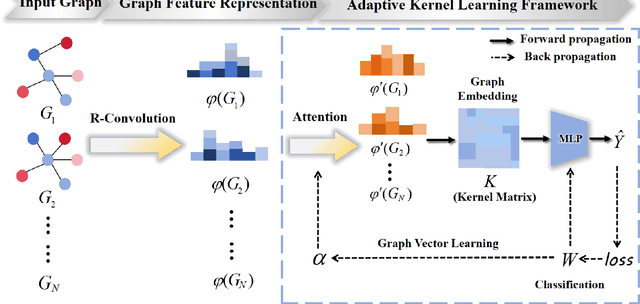
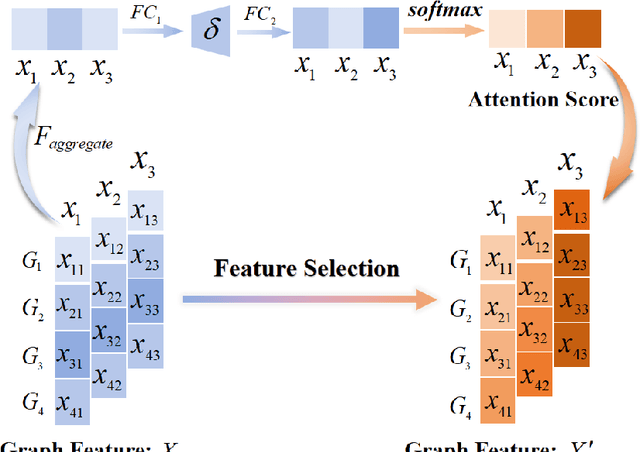
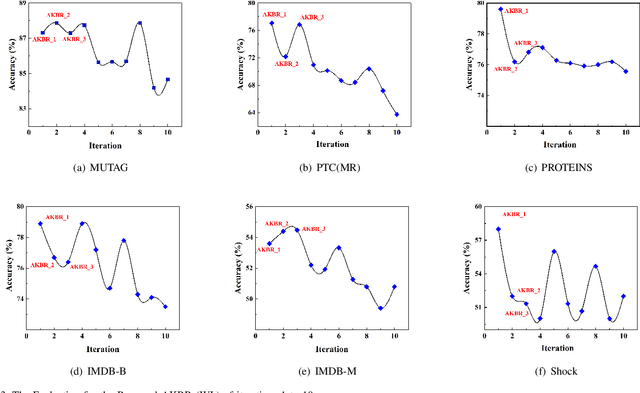

Abstract:In this paper, we propose a new model to learn Adaptive Kernel-based Representations (AKBR) for graph classification. Unlike state-of-the-art R-convolution graph kernels that are defined by merely counting any pair of isomorphic substructures between graphs and cannot provide an end-to-end learning mechanism for the classifier, the proposed AKBR approach aims to define an end-to-end representation learning model to construct an adaptive kernel matrix for graphs. To this end, we commence by leveraging a novel feature-channel attention mechanism to capture the interdependencies between different substructure invariants of original graphs. The proposed AKBR model can thus effectively identify the structural importance of different substructures, and compute the R-convolution kernel between pairwise graphs associated with the more significant substructures specified by their structural attentions. Since each row of the resulting kernel matrix can be theoretically seen as the embedding vector of a sample graph, the proposed AKBR model is able to directly employ the resulting kernel matrix as the graph feature matrix and input it into the classifier for classification (i.e., the SoftMax layer), naturally providing an end-to-end learning architecture between the kernel computation as well as the classifier. Experimental results show that the proposed AKBR model outperforms existing state-of-the-art graph kernels and deep learning methods on standard graph benchmarks.
Dual-modal Prior Semantic Guided Infrared and Visible Image Fusion for Intelligent Transportation System
Mar 24, 2024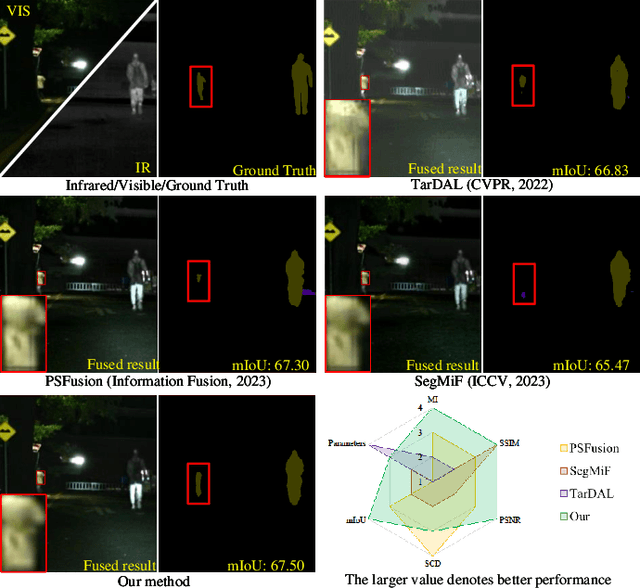
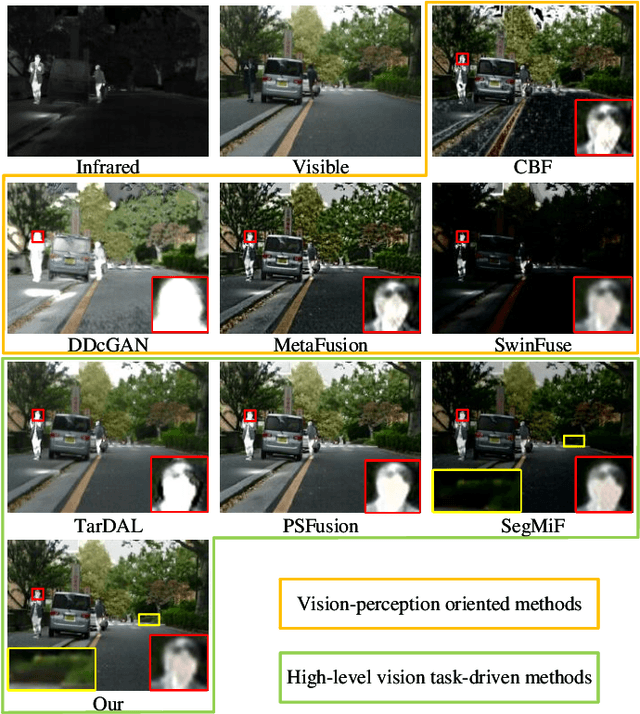
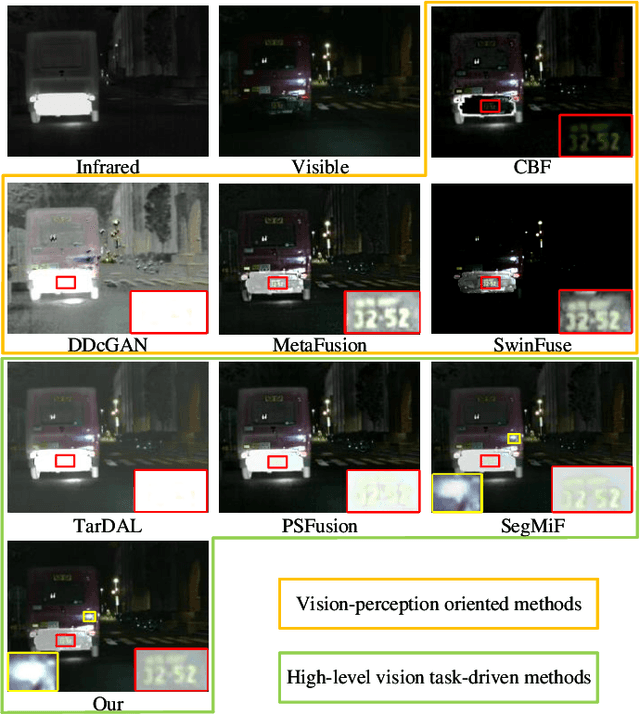
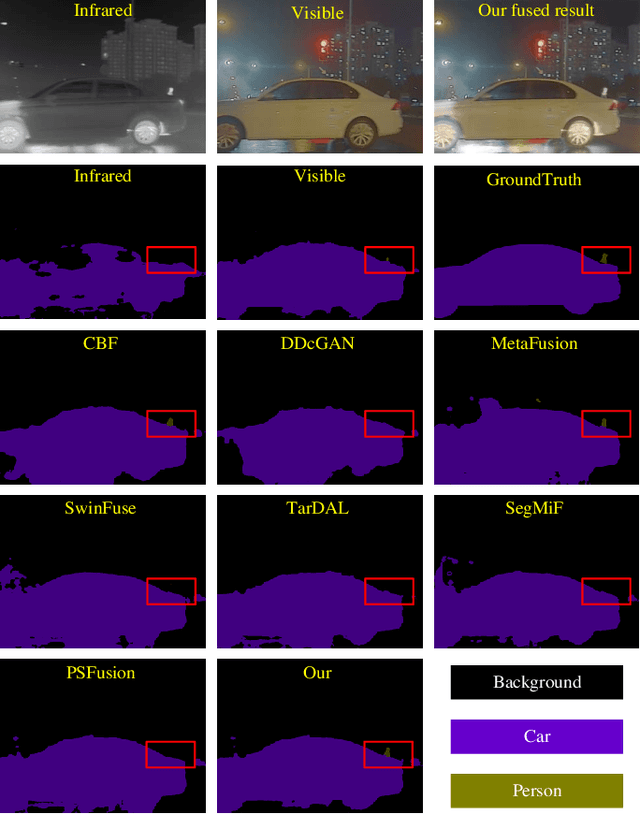
Abstract:Infrared and visible image fusion (IVF) plays an important role in intelligent transportation system (ITS). The early works predominantly focus on boosting the visual appeal of the fused result, and only several recent approaches have tried to combine the high-level vision task with IVF. However, they prioritize the design of cascaded structure to seek unified suitable features and fit different tasks. Thus, they tend to typically bias toward to reconstructing raw pixels without considering the significance of semantic features. Therefore, we propose a novel prior semantic guided image fusion method based on the dual-modality strategy, improving the performance of IVF in ITS. Specifically, to explore the independent significant semantic of each modality, we first design two parallel semantic segmentation branches with a refined feature adaptive-modulation (RFaM) mechanism. RFaM can perceive the features that are semantically distinct enough in each semantic segmentation branch. Then, two pilot experiments based on the two branches are conducted to capture the significant prior semantic of two images, which then is applied to guide the fusion task in the integration of semantic segmentation branches and fusion branches. In addition, to aggregate both high-level semantics and impressive visual effects, we further investigate the frequency response of the prior semantics, and propose a multi-level representation-adaptive fusion (MRaF) module to explicitly integrate the low-frequent prior semantic with the high-frequent details. Extensive experiments on two public datasets demonstrate the superiority of our method over the state-of-the-art image fusion approaches, in terms of either the visual appeal or the high-level semantics.
SSHPool: The Separated Subgraph-based Hierarchical Pooling
Mar 24, 2024Abstract:In this paper, we develop a novel local graph pooling method, namely the Separated Subgraph-based Hierarchical Pooling (SSHPool), for graph classification. To this end, we commence by assigning the nodes of a sample graph into different clusters, resulting in a family of separated subgraphs. We individually employ a local graph convolution units as the local structure to further compress each subgraph into a coarsened node, transforming the original graph into a coarsened graph. Since these subgraphs are separated by different clusters and the structural information cannot be propagated between them, the local convolution operation can significantly avoid the over-smoothing problem arising in most existing Graph Neural Networks (GNNs). By hierarchically performing the proposed procedures on the resulting coarsened graph, the proposed SSHPool can effectively extract the hierarchical global feature of the original graph structure, encapsulating rich intrinsic structural characteristics. Furthermore, we develop an end-to-end GNN framework associated with the proposed SSHPool module for graph classification. Experimental results demonstrate the superior performance of the proposed model on real-world datasets, significantly outperforming state-of-the-art GNN methods in terms of the classification accuracies.
AERK: Aligned Entropic Reproducing Kernels through Continuous-time Quantum Walks
Mar 04, 2023Abstract:In this work, we develop an Aligned Entropic Reproducing Kernel (AERK) for graph classification. We commence by performing the Continuous-time Quantum Walk (CTQW) on each graph structure, and computing the Averaged Mixing Matrix (AMM) to describe how the CTQW visit all vertices from a starting vertex. More specifically, we show how this AMM matrix allows us to compute a quantum Shannon entropy for each vertex of a graph. For pairwise graphs, the proposed AERK kernel is defined by computing a reproducing kernel based similarity between the quantum Shannon entropies of their each pair of aligned vertices. The analysis of theoretical properties reveals that the proposed AERK kernel cannot only address the shortcoming of neglecting the structural correspondence information between graphs arising in most existing R-convolution graph kernels, but also overcome the problem of neglecting the structural differences between pairs of aligned vertices arising in existing vertex-based matching kernels. Moreover, unlike existing classical graph kernels that only focus on the global or local structural information of graphs, the proposed AERK kernel can simultaneously capture both global and local structural information through the quantum Shannon entropies, reflecting more precise kernel based similarity measures between pairs of graphs. The above theoretical properties explain the effectiveness of the proposed kernel. The experimental evaluation on standard graph datasets demonstrates that the proposed AERK kernel is able to outperform state-of-the-art graph kernels for graph classification tasks.
QESK: Quantum-based Entropic Subtree Kernels for Graph Classification
Dec 10, 2022
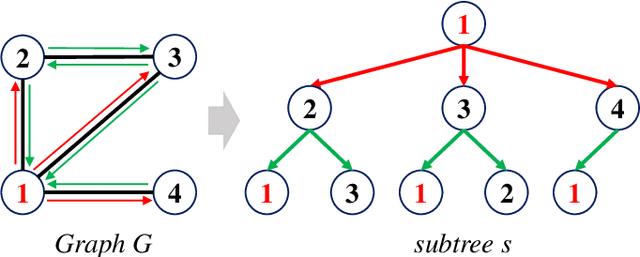
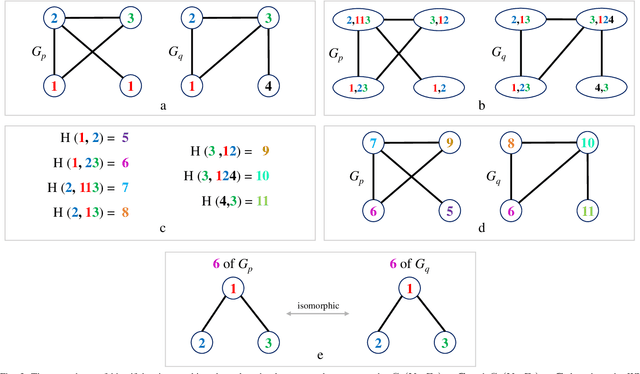

Abstract:In this paper, we propose a novel graph kernel, namely the Quantum-based Entropic Subtree Kernel (QESK), for Graph Classification. To this end, we commence by computing the Average Mixing Matrix (AMM) of the Continuous-time Quantum Walk (CTQW) evolved on each graph structure. Moreover, we show how this AMM matrix can be employed to compute a series of entropic subtree representations associated with the classical Weisfeiler-Lehman (WL) algorithm. For a pair of graphs, the QESK kernel is defined by computing the exponentiation of the negative Euclidean distance between their entropic subtree representations, theoretically resulting in a positive definite graph kernel. We show that the proposed QESK kernel not only encapsulates complicated intrinsic quantum-based structural characteristics of graph structures through the CTQW, but also theoretically addresses the shortcoming of ignoring the effects of unshared substructures arising in state-of-the-art R-convolution graph kernels. Moreover, unlike the classical R-convolution kernels, the proposed QESK can discriminate the distinctions of isomorphic subtrees in terms of the global graph structures, theoretically explaining the effectiveness. Experiments indicate that the proposed QESK kernel can significantly outperform state-of-the-art graph kernels and graph deep learning methods for graph classification problems.
HAQJSK: Hierarchical-Aligned Quantum Jensen-Shannon Kernels for Graph Classification
Nov 08, 2022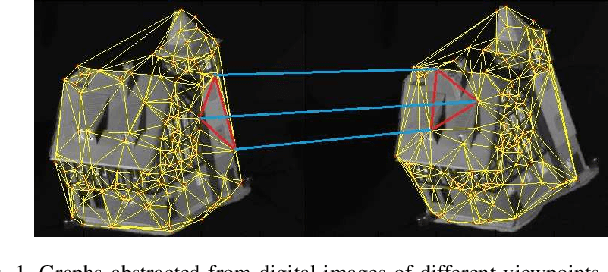
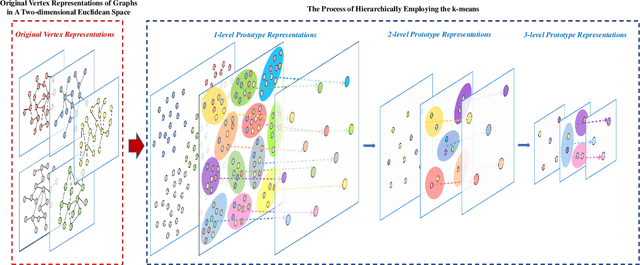

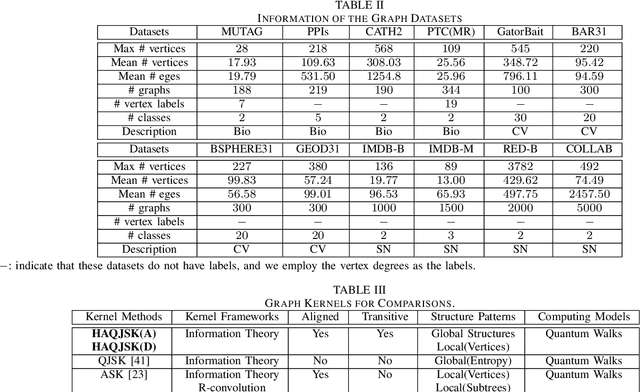
Abstract:In this work, we propose a family of novel quantum kernels, namely the Hierarchical Aligned Quantum Jensen-Shannon Kernels (HAQJSK), for un-attributed graphs. Different from most existing classical graph kernels, the proposed HAQJSK kernels can incorporate hierarchical aligned structure information between graphs and transform graphs of random sizes into fixed-sized aligned graph structures, i.e., the Hierarchical Transitive Aligned Adjacency Matrix of vertices and the Hierarchical Transitive Aligned Density Matrix of the Continuous-Time Quantum Walk (CTQW). For a pair of graphs to hand, the resulting HAQJSK kernels are defined by measuring the Quantum Jensen-Shannon Divergence (QJSD) between their transitive aligned graph structures. We show that the proposed HAQJSK kernels not only reflect richer intrinsic global graph characteristics in terms of the CTQW, but also address the drawback of neglecting structural correspondence information arising in most existing R-convolution kernels. Furthermore, unlike the previous Quantum Jensen-Shannon Kernels associated with the QJSD and the CTQW, the proposed HAQJSK kernels can simultaneously guarantee the properties of permutation invariant and positive definiteness, explaining the theoretical advantages of the HAQJSK kernels. Experiments indicate the effectiveness of the proposed kernels.
Collaborative Knowledge Graph Fusion by Exploiting the Open Corpus
Jun 15, 2022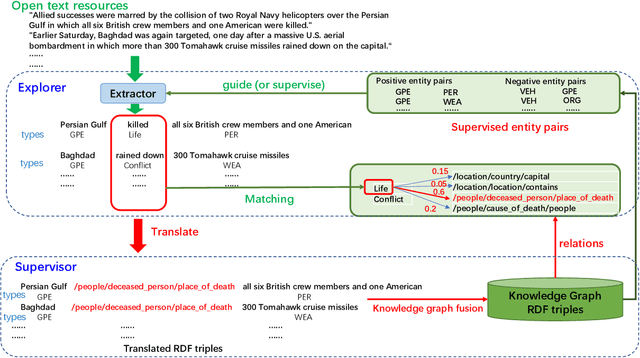

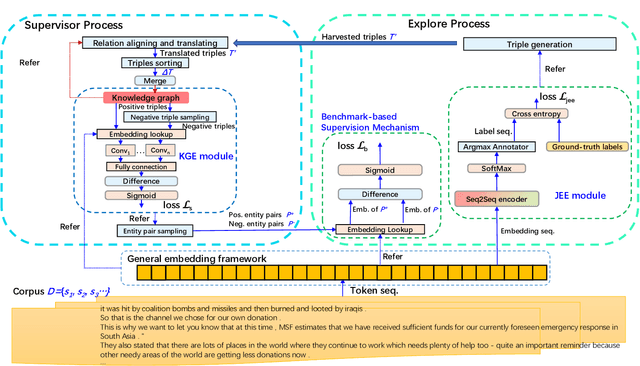

Abstract:To alleviate the challenges of building Knowledge Graphs (KG) from scratch, a more general task is to enrich a KG using triples from an open corpus, where the obtained triples contain noisy entities and relations. It is challenging to enrich a KG with newly harvested triples while maintaining the quality of the knowledge representation. This paper proposes a system to refine a KG using information harvested from an additional corpus. To this end, we formulate our task as two coupled sub-tasks, namely join event extraction (JEE) and knowledge graph fusion (KGF). We then propose a Collaborative Knowledge Graph Fusion Framework to allow our sub-tasks to mutually assist one another in an alternating manner. More concretely, the explorer carries out the JEE supervised by both the ground-truth annotation and an existing KG provided by the supervisor. The supervisor then evaluates the triples extracted by the explorer and enriches the KG with those that are highly ranked. To implement this evaluation, we further propose a Translated Relation Alignment Scoring Mechanism to align and translate the extracted triples to the prior KG. Experiments verify that this collaboration can both improve the performance of the JEE and the KGF.
 Add to Chrome
Add to Chrome Add to Firefox
Add to Firefox Add to Edge
Add to Edge